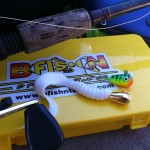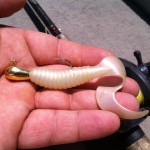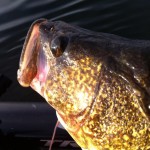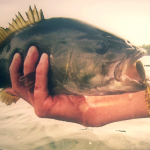Apply an ice-jigger’s mentality and put specialized jigs right in the thick of things all summer. Large, deep structures on big water call for vertical fishing with surgical precision.
By mid-summer, the bulk of the jigging I do for walleye is vertically. The water is typically from twenty five to forty feet deep and usually very exposed to wind. Bottom content ranges from fairly gentle, ‘transition-type’ areas to sharp, rocky features. Considering what’s involved, heavy, compact presentations that fish accurately become one of the best choices for feel and control in these tight spots. Lures from 5/8 to a full ounce or more are generally larger than most are used to using, and typically reserved for fishing around moving water. Big jigs are a big-water staple for me, and once you start looking at the fishing conditions and what’s needed to make walleye bite, they make a lot of sense.
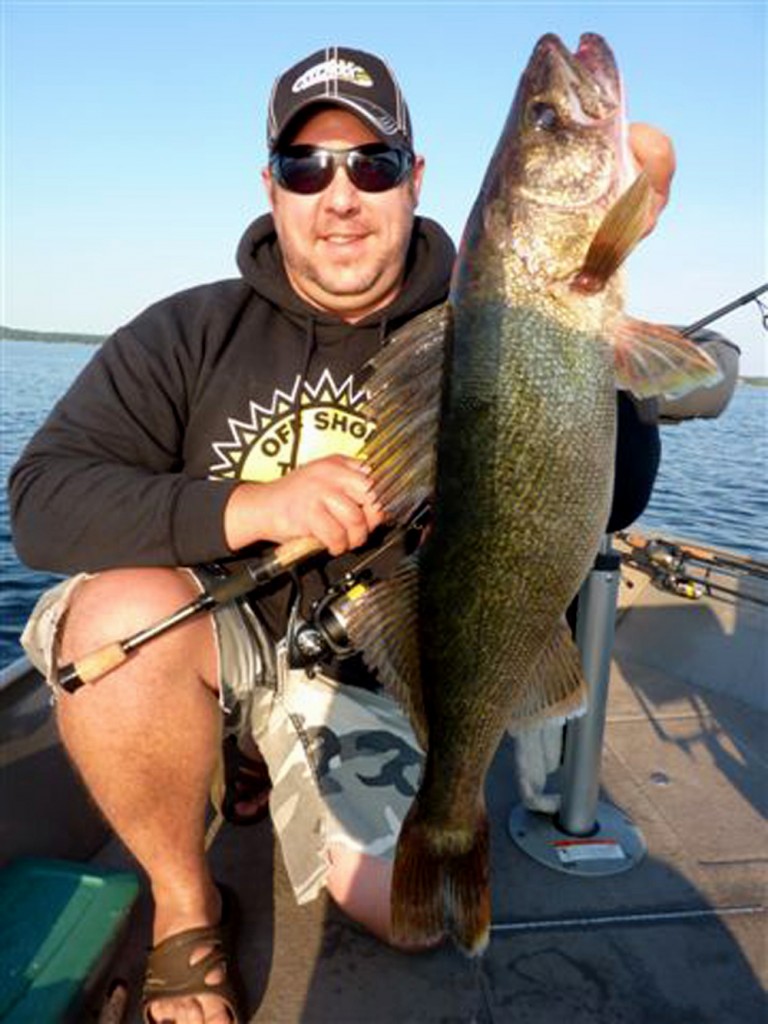 Jigging is slow-paced overall. The best areas are typically confined, with walleye using very specific zones. Big water usually means big spots. Fishing individual shoals measuring an acre or more in size isn’t uncommon. Once fish show up on sonar, the focus then turns to dropping lures directly on top of them. In some cases, pods of fish can be dotted all over the same general structure. You can pick a few off one area before sliding on top of the next and starting all over on a new school. Precise boat control and good sonar work make up two-thirds of the puzzle. Piece number three involves an efficient method of not only triggering walleye to bite, but efficiently ‘staying on them’ while you work them. There’s no better method for targeting small areas in deep water than vertical jigging. And the heavier the jig, the faster and more accurately you can use it. Just like through a hole in the ice, you can use your bait and the sonar to see how fish react, then feed it right to them. The technique is actually very similar to ice fishing.
Jigging is slow-paced overall. The best areas are typically confined, with walleye using very specific zones. Big water usually means big spots. Fishing individual shoals measuring an acre or more in size isn’t uncommon. Once fish show up on sonar, the focus then turns to dropping lures directly on top of them. In some cases, pods of fish can be dotted all over the same general structure. You can pick a few off one area before sliding on top of the next and starting all over on a new school. Precise boat control and good sonar work make up two-thirds of the puzzle. Piece number three involves an efficient method of not only triggering walleye to bite, but efficiently ‘staying on them’ while you work them. There’s no better method for targeting small areas in deep water than vertical jigging. And the heavier the jig, the faster and more accurately you can use it. Just like through a hole in the ice, you can use your bait and the sonar to see how fish react, then feed it right to them. The technique is actually very similar to ice fishing.
Becoming One With Your Weight
Heavy jigs fished on thin, sensitive superlines or braids really are the ultimate in feel and efficiency. The package gets down fast, and you’re able to stay on target with the least possible amount of line out. Why is this important? For one, heavy jigs are a lot more prone to hanging up on bottom than lighter ones are. Being able to walk up and over the bottom, as opposed to dragging along it–with more line out and at a greater angle– is critical. It’s amazing how easily you can work big jigs through bad rocks when you stay directly on top of them, vertically. Line tests from 15 to 30lb are ideal. And of course, you get excellent feel with short lengths of no-stretch line, straight under the boat. I started jigging with Maxima’s new Braid 8 this time last summer, and love it. It’s limp, extremely thin and had all kinds of dead-pull strength.
When the wind’s up and you’re battling to stay on a spot the size of a tennis court, having to break off and re-tie jigs will frustrate you fast. Once you’re set-up correctly, expect to put lots of miles on a single jig before losing it. They get down and stay down. You’ll fish effectively and for long periods of time. A good basic set-up matches superline or braid with about four feet of fifteen pound fluorocarbon tied off to a tiny, inline swivel. High-visibility mainlines are really nice. You can see the angle of your line and where your jig is laying relative to the boat very easily. You’ll feel every rock, pebble or patch of soft bottom. These changes are worth noticing, and can be exactly what holds walleye. Bites are crisp, and setting the hook is normally just a matter of a firm lift. This is definitely a presentation where no-stretch lines shine.
Efficiencies Of Scale
Walleye over firm to hard bottoms show up very well on a good sonar in twenty to forty feet of water. GPS/Sonar units are critical for pinpointing individual groupings of fish. Take it a step further and toss out a marker buoy just off to the side of the action for a quick, visual reference everyone in the boat can relate to. Your plotter will periodically bounce around and ‘lose you’ when you’re working at low speeds in small areas, and having the buoy out makes getting back on your spot basically instant. Big water usually means lots of areas to check. Good areas tend to hold walleyes you can jig over year after year, and these are the places to begin poking around. If they’re not showing up, idle around spots until you find them. With GPS waypoints and mapping, you can run on plane for miles, pull up directly over key spots and start fishing with virtually zero downtime. This kind of technology puts you at a huge advantage for jigging. The pace is slow enough as it is. Having to hunt around really cuts down on your efficiency. Zoom in on your plotter as you near the target. You’ll be on the money fast. There’s really no point in stopping and setting up a jigging pass if you’re not marking fish. Cruise your structures, and only begin slicing them apart after your electronics tell you to. Innovations like MinnKota’s i-Pilot and Spot Lock allow you to hover over hot zones, letting you focus on feel, rather than driving. Along with a sonar/plotter combo, this might the most key tool for vertical jigging. I take plenty of fish from anchored positions all summer, too. You can actually comb big sections of structure in windy conditions while anchored. Paying out rope gets the boat swaying in an arc, letting you ‘fan jig’ a big area under complete control.

Dressing Up For Work
Tipping with a range of baits and dressings helps cover more of the spot and tests what walleye like best. You can actually watch fish and how they respond to what you’re doing, using your graph. Where I do the bulk of my jigging, the most productive zones are from right on bottom up to about four feet above it. Fish that won’t take down low can sometimes be teased up before hitting. A walleye’s ‘upper limit’ for chasing changes all the time. Some days, they’ll put on the brakes after only foot or two. Really active fish can come a lot further, sometimes grabbing the jig before it reaches bottom on that first drop. Plastics and biodegradable baits have a really solid ‘closing ratio’ on fish we get to chase. Their vibrations and colour has to be a big reason for this, along with the way they smell and taste. Big jigs are loud when they smack the bottom, and displace lots of water overall. In deep water, I’ve always felt that sound and disturbance are important. Gord Pyzer has written on this for years. Heavy jigs really give walleye something to find and hit. Gord’s a real pioneer in the ‘big jig, big walleye’ game, taking huge fish on pike or lake trout-sized baits all season.
Tipping jigs on bigger bodies of water is just as important as on smaller lakes or rivers. One of our sleepers lately has been a big, five-inch Mister Twister curly tail in UV pearl white. It’s a grub with enough meat to tip a big spinnerbait. On a 3/4oz head, it probably looks a lot like a smelt. The profile is long and slender and the tail gives off a good shimmy. Not exactly what most would think of trying, but a great shape for fish that are used to eating fully grown smelts. I actually like buying plain, un-painted heads poured on quality hooks and airbrushing them myself over the winter. Two-tone jigs in complimentary colours have always worked well for me, in combinations like purple/silver, orange/chartreuse, pink/white and lime/chartreuse. Sometimes plain, unpainted lead is just as good. You don’t see them around as often, but metallic jig heads can be hot, especially gold.
With larger plastics and bulked up live minnows, having the big weight is only half of it. The hook is critical. A long shank and big gap is perfect for and a big gap and shorter shank matches well with live bait. Leeches, full or half nightcrawlers and a variety of minnows all work. In deep water, most days it’s hard to beat a four to six inch chub or sucker, if you like live bait. Meatier grubs like Mr. Twister’s five incher are safe play, most of the time. Fork-tailed bodies in the ‘finesse minnow’ shape are historically great lures on big bodies of water, too. Today’s scented, salted or biodegradable lures are perfect for vertical jigging. I’m still not sure what it is about UV reactive soft plastics, but I’ve seen them beat out regular plastics many times, in deep water. In the clearer waters I fish most often, jigging aggressively on bright days is a situation where they shine. Even down in twenty five and thirty-plus feet of water, they’ve got that something extra. I’ve used Mister Twister soft baits for close to thirty years with consistent success. I’d say that’s a pretty solid track record. They’ve got a new, hot pink with white inlay that’s begging for a few deep snaps on my shoals this summer.
Transporting live minnows is definitely a hot button issue where I fish, but there are clearly days when they’re what the walleye want. I’ve got an old, 10’ Frabill seine net that I roll up in a rod locker in the boat. I fish with my young sons regularly, and dipping out a bunch of shiners from a bay 200 yards from where we’re fishing is fun and rewarding. All the ones we don’t use get released right back into the water. That’s about as ‘lake-friendly’ as livebaiting gets, in my opinion.
A variety of jighead shapes work for staying vertical in deep water. For me, the Precision Jig from B Fishin Tackle just makes the whole routine easier. The head has a tapered shoulder, almost like a bell sinker, with a wire keeper barb tucked in behind, for securing rubber trailers. Many days, we’re popping jigs off nasty rocks or snapping them to get fish reacting. That barb makes a huge difference, keeping trailers sitting and moving the way they should. They paint process used is phenomenal. You can put hundreds of hours on these jigs with no chipping. And you’ll get to test that longevity, too. These are the best jigs for walking through bad rocks I’ve ever used. I’m still working walleye with a 5/8oz from August of 2013! They just don’t hang up. Having to retie takes a presentation that’s slow enough as it is and basically grinds it to a halt. A durable, no-snag jig makes this whole package hum. They come in some fantastic colour patterns, too. That keeper barb is great for tagging live nightcrawlers, too.
Details Are The Difference-Makers
Jigs with the line tie set at 90 degrees are best for fishing up and down, and hundreds of them available from big companies and basement guys alike. Regardless of the dressing, heavy jigs sit with a nose-down attitude on bottom. Whatever’s attached to the back end stands up, for the most part. A big minnow anchored in place, fighting the little lead ball, is as easy as it gets for a walleye. Plastics flap around nicely, too. Throw in a few slow lifts or sharper snaps between long pauses and you can trigger walleye in almost any mood, once you’ve found them. The longer the free-fall, the harder the jig hits and the more your trailer will stand up. This also protects your hook point from wear. I stuff my pike and muskie tubes with up to six ounces of lead for the same reasons when fishing rough bottom.
Wind makes any style of fishing tough, let alone precision vertical jigging. It’s usually what dictates what you can or can’t do. But when conditions allow, targeting walleyes on deeper structure at off-peak hours with the right set-up can be very effective. When there’s a good chop I won’t hesitate to get the bowmount pointed straight into the wind and fish the biggest jigs in the box. Once I get over top of the activity, the bait gets into the wheelhouse fast. I can see it on my graph, and feel exactly what’s happening. Jigs are cheap, and you’ve probably already got the rods and reels needed to do it. With the heaviest weights, a baitcast set-up very similar to a bottom bouncing combo works well. Casting reels with the ‘flippin’ feature let you feed line and follow the bottom one-handed. Shorter rods keep lures as close to the transducer cone as possible. Lengths of six to six and a half feet work best for me fishing out of a deep “V” boat, where the gunnels are considerably higher off the water than on a bass boat.
And just to be clear, lead head jigs aren’t the only play in these situations. You’ve got options. Heavy, compact jigging baits like the Jigging Rapala and spoons like the Williams Bully or Mr. Champ also work. Ice baits like Lindy Slick Jigs, Blue Fox Foxxee Minnows or Badd Boyz are perfect. Crafted mainly from lead, these baits fish up and down very well, and normally come with over-sized hooks. Tipping with today’s high-tech plastic and biodegradable baits becomes a bigger part of the walleye fishermen’s attack every year. With the explosion of gobies in many fisheries, live baits can be expensive and time-consuming to use. Plastics are perfectly suited to jigging’s version of ‘power fishing.’
If you’re seeing good marks down deep this summer, try experimenting with bulked up jigs. Deliver them on target as accurately as possible, from directly overhead. It’s hands-on, very direct and walleye like it. By all means, have someone using natural bait and another using plastic. Fish slower and gentler with bait, and move plastics more often and more abruptly. Bonus species routinely include giant smallmouth bass, jumbo perch and some very big pike. Nothing wrong with that!
 JP Bushey
JP Bushey
JP Bushey is a multi-season, multi-species writer from Barrie, Ontario. Northcentral Ontario’s ‘big water’ is where he spends his time, including Georgian Bay, Lake Nipissing, The French River and The Bay of Quinte. He does speaking engagements, manufactures lures and takes pride in helping people improve their fishing success. You can follow his fishing adventures on Facebook at The Bushey Angle, and on the web at www.thebusheyangle.com




